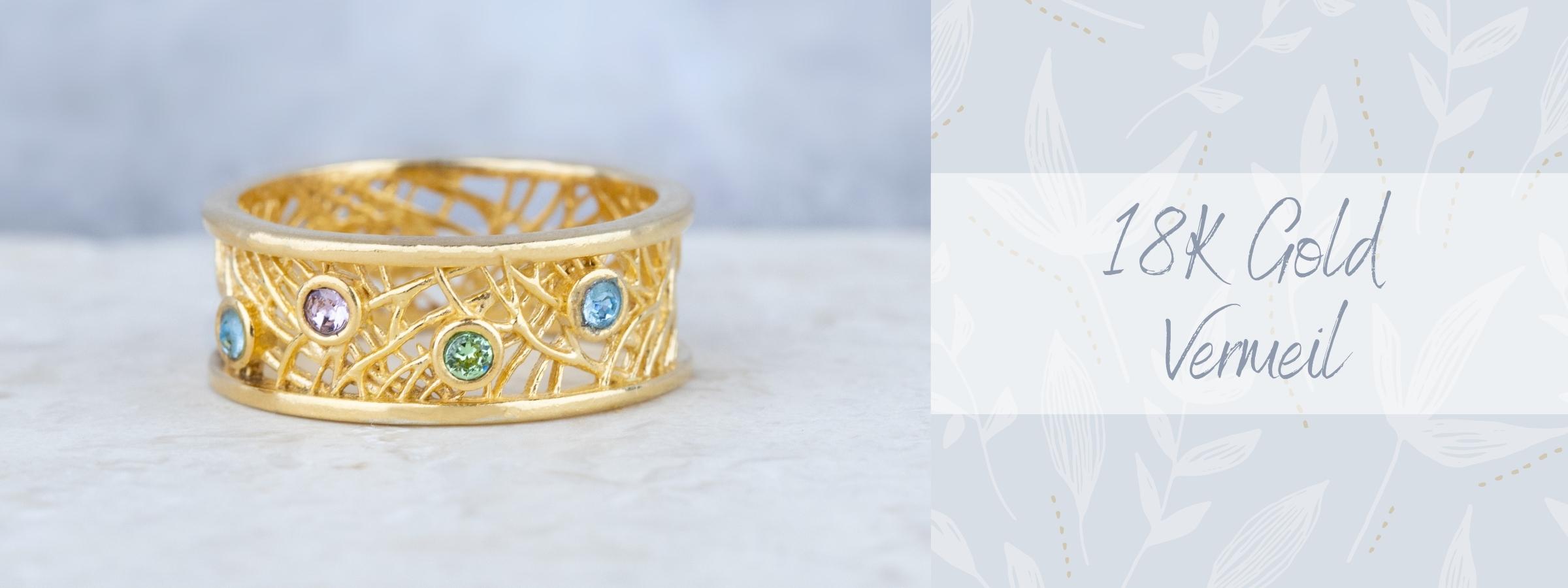Understanding the realm of fine jewelry can be a dizzying experience, particularly given the multitude of options available. Among these, 18k gold vermeil stands out as a refined and sophisticated choice for those seeking elegance without the hefty price tag of solid gold. But what exactly is 18k gold vermeil? This article delves into its definition, composition, history, advantages, care instructions, and the differences between similar materials.
Defining 18k Gold Vermeil
At its core, 18k gold vermeil is a specific type of gold plating that encompasses a thin layer of gold—at least 18 karats thick—applied to a base metal, typically sterling silver. The term “vermeil” itself is derived from the French word for “gilded” and indicates a material that not only possesses the elegance of gold but also maintains the integrity and durability of sterling silver. The legal standards for vermeil require that the gold layer be at least 2.5 microns thick, making it notably more robust than standard gold-plated items.
The Composition of 18k Gold Vermeil
18K gold indicates that 75% of the material is pure gold, while the remaining 25% consists of other metals, which often include silver, copper, or palladium. The alloying process enhances the metal’s durability and modifies its color. For instance, copper may yield a warmer, rose-hued finish, while palladium can introduce a subtler, cooler tone. The underlying sterling silver provides a sturdy substrate, contributing to the overall resilience of the piece.
A Brief Historical Journey
The practice of gilding objects dates back millennia, with ancient civilizations like the Egyptians and Romans utilizing gold layering techniques to adorn everything from jewelry to ceremonial artifacts. The emergence of vermeil as a distinct category began in France, where it was employed in luxury items for the aristocracy. Over time, the demand for accessible, yet luxurious jewelry led to the popularization of vermeil in contemporary craftsmanship. Today, it remains a favorite for both designers and consumers alike, embodying a harmonious blend of opulence and affordability.
The Advantages of 18k Gold Vermeil
1. Aesthetic Appeal: One of the most palpable benefits of 18k gold vermeil is its striking resemblance to solid gold. Its warm hues and lustrous sheen can elevate any ensemble, from casual wear to more formal attire.
2. Affordability: Compared to solid gold, which can be prohibitively expensive, 18k gold vermeil offers an alluring compromise. Consumers enjoy the luxurious appearance without the financial burden.
3. Diversity of Styles: Artisans have embraced 18k gold vermeil for its versatility. Whether one seeks minimalist designs or intricate creations adorned with gemstones, there is a veritable cornucopia of options available that cater to varied tastes.
4. Hypoallergenic Qualities: The sterling silver base often boasts hypoallergenic properties, making 18k gold vermeil a preferred choice for those with sensitive skin. In contrast to other plated materials, it minimizes the risk of irritation.
Caring for 18k Gold Vermeil 1. Cleaning: Use a soft cloth to gently wipe off dirt or grime after each wear. For deeper cleaning, a mild soap solution and water can suffice; however, avoid abrasive materials that could scratch the surface.
2. Avoiding Exposure: Limit contact with harsh chemicals, including perfumes, lotions, and cleaning agents, which can compromise the gold layer. Additionally, remove jewelry before swimming or showering.
3. Storage: Store vermeil jewelry in a cool, dry place, preferably in a fabric-lined box or pouch that prevents scratching and tarnishing. If possible, wrap pieces individually to minimize friction during storage.
Distinguishing 18k Gold Vermeil from Other Alternatives
While 18k gold vermeil holds a unique position within the jewelry landscape, it’s essential to differentiate it from similar materials:
1. Gold-Plated Jewelry: Unlike vermeil, traditional gold-plated items typically have a thinner layer of gold and may not adhere to the same thickness standards. Thus, they are more prone to wear-off and tarnishing.
2. Solid Gold: Solid gold jewelry is pure gold throughout and does not contain other metals. While it has superior durability and resale value, it comes at a significantly greater cost.
3. Gold-Filled Jewelry: Gold-filled items contain a thicker layer of gold bonded to a base metal. Although more durable than gold plating, they are generally not as refined or luxurious as vermeil.
Final Thoughts
In conclusion, 18k gold vermeil represents an exquisite fusion of beauty, affordability, and craftsmanship, making it a staple in modern jewelry collections. Its rich history, coupled with the exceptional qualities it offers, provides a compelling option for those looking to adorn themselves with elegant pieces that reflect their personal style. By arming oneself with knowledge about this precious material, consumers can make informed decisions and find joy in their jewelry selections, ensuring they enjoy both the aesthetic and emotional benefits that such treasures bestow.
